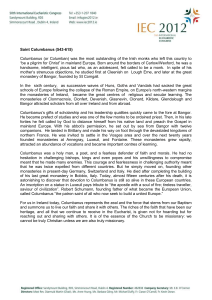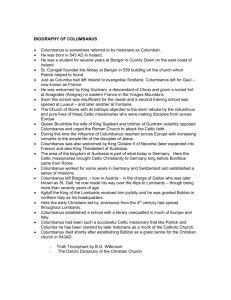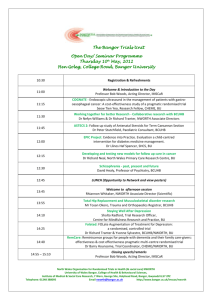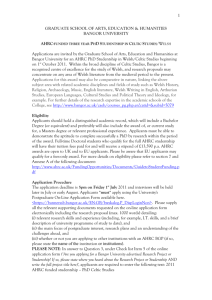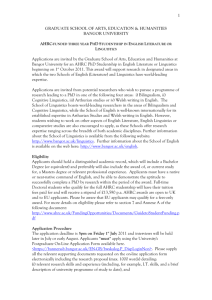St. Columbanus - Carlow Tourism
advertisement
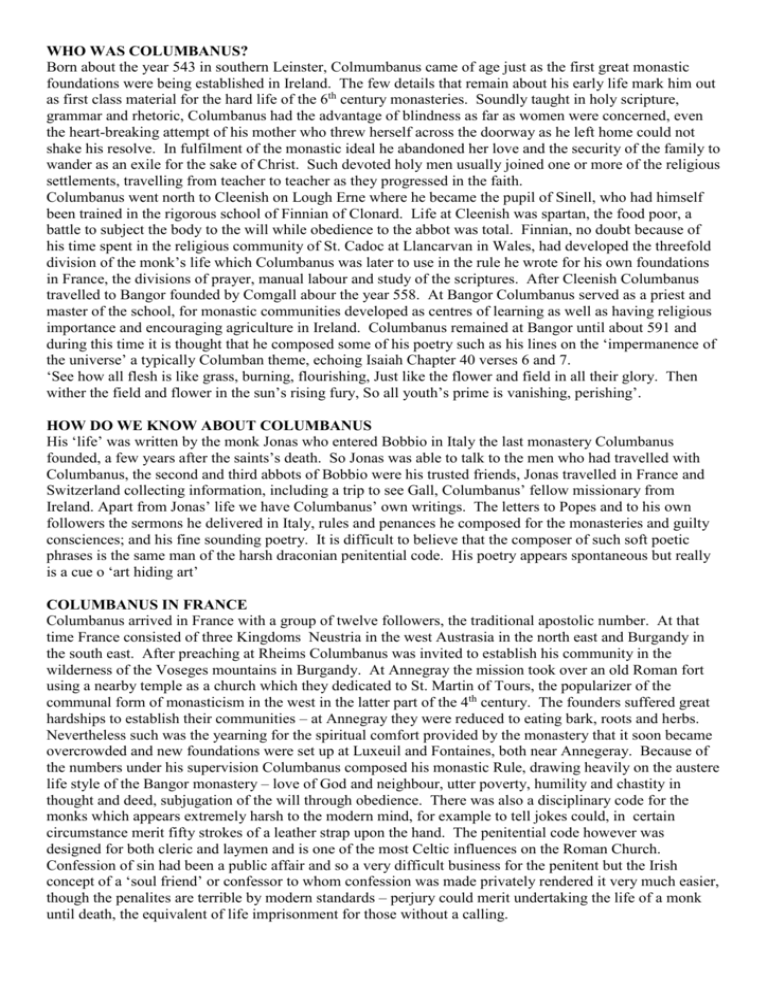
WHO WAS COLUMBANUS? Born about the year 543 in southern Leinster, Colmumbanus came of age just as the first great monastic foundations were being established in Ireland. The few details that remain about his early life mark him out as first class material for the hard life of the 6th century monasteries. Soundly taught in holy scripture, grammar and rhetoric, Columbanus had the advantage of blindness as far as women were concerned, even the heart-breaking attempt of his mother who threw herself across the doorway as he left home could not shake his resolve. In fulfilment of the monastic ideal he abandoned her love and the security of the family to wander as an exile for the sake of Christ. Such devoted holy men usually joined one or more of the religious settlements, travelling from teacher to teacher as they progressed in the faith. Columbanus went north to Cleenish on Lough Erne where he became the pupil of Sinell, who had himself been trained in the rigorous school of Finnian of Clonard. Life at Cleenish was spartan, the food poor, a battle to subject the body to the will while obedience to the abbot was total. Finnian, no doubt because of his time spent in the religious community of St. Cadoc at Llancarvan in Wales, had developed the threefold division of the monk’s life which Columbanus was later to use in the rule he wrote for his own foundations in France, the divisions of prayer, manual labour and study of the scriptures. After Cleenish Columbanus travelled to Bangor founded by Comgall abour the year 558. At Bangor Columbanus served as a priest and master of the school, for monastic communities developed as centres of learning as well as having religious importance and encouraging agriculture in Ireland. Columbanus remained at Bangor until about 591 and during this time it is thought that he composed some of his poetry such as his lines on the ‘impermanence of the universe’ a typically Columban theme, echoing Isaiah Chapter 40 verses 6 and 7. ‘See how all flesh is like grass, burning, flourishing, Just like the flower and field in all their glory. Then wither the field and flower in the sun’s rising fury, So all youth’s prime is vanishing, perishing’. HOW DO WE KNOW ABOUT COLUMBANUS His ‘life’ was written by the monk Jonas who entered Bobbio in Italy the last monastery Columbanus founded, a few years after the saints’s death. So Jonas was able to talk to the men who had travelled with Columbanus, the second and third abbots of Bobbio were his trusted friends, Jonas travelled in France and Switzerland collecting information, including a trip to see Gall, Columbanus’ fellow missionary from Ireland. Apart from Jonas’ life we have Columbanus’ own writings. The letters to Popes and to his own followers the sermons he delivered in Italy, rules and penances he composed for the monasteries and guilty consciences; and his fine sounding poetry. It is difficult to believe that the composer of such soft poetic phrases is the same man of the harsh draconian penitential code. His poetry appears spontaneous but really is a cue o ‘art hiding art’ COLUMBANUS IN FRANCE Columbanus arrived in France with a group of twelve followers, the traditional apostolic number. At that time France consisted of three Kingdoms Neustria in the west Austrasia in the north east and Burgandy in the south east. After preaching at Rheims Columbanus was invited to establish his community in the wilderness of the Voseges mountains in Burgandy. At Annegray the mission took over an old Roman fort using a nearby temple as a church which they dedicated to St. Martin of Tours, the popularizer of the communal form of monasticism in the west in the latter part of the 4th century. The founders suffered great hardships to establish their communities – at Annegray they were reduced to eating bark, roots and herbs. Nevertheless such was the yearning for the spiritual comfort provided by the monastery that it soon became overcrowded and new foundations were set up at Luxeuil and Fontaines, both near Annegeray. Because of the numbers under his supervision Columbanus composed his monastic Rule, drawing heavily on the austere life style of the Bangor monastery – love of God and neighbour, utter poverty, humility and chastity in thought and deed, subjugation of the will through obedience. There was also a disciplinary code for the monks which appears extremely harsh to the modern mind, for example to tell jokes could, in certain circumstance merit fifty strokes of a leather strap upon the hand. The penitential code however was designed for both cleric and laymen and is one of the most Celtic influences on the Roman Church. Confession of sin had been a public affair and so a very difficult business for the penitent but the Irish concept of a ‘soul friend’ or confessor to whom confession was made privately rendered it very much easier, though the penalites are terrible by modern standards – perjury could merit undertaking the life of a monk until death, the equivalent of life imprisonment for those without a calling. TROUBLE WITH THE AUTHORITIES France was nominally a Christian country long before the arrival of St. Columbanus. St. Patrick is believed to have trained there before his return to Ireland. But Irish ways were not those of France and French abbots were expected to be subordinate to Bishops. Acting as an abbot Columbanus had established his monasteries without their authority and his ideas on the Celebration of Easter differed from theirs. In attracting Christians to his ideas on penance he was also infringing the law of the French Church, but until 610 Columbanus was permitted to work unimpeded. Relations with the court of Burgandy had worsened ever since the time Columbanus offended the King of Burngandy Theodoric by refusing to bless his illegitimate children. Such a refusal was a dangerous blow to their claims to the throne and a succession of weak rulers in 6th century France had led to civil war. In 610 Columnbanus was forced into exile and escorted right across France to Nantes by an armed guard to ensure that he left the country. During the journey he healed many people and on his arrival at Nantes he wrote to his brethren at Luxeuil instructing them to beware of disagreements amongst themselves which might be used as pretexts for dissolving their community. Columbanus embarked but never reached Ireland The master of the ship carrying him interpreted the continuous bad weather he met with at the mouth of the river Loire as a divine sign that Columbanus was not to leave France. Perhaps Columbanus also told him that his name was the Irish equivalent of Jonah! SWITZERLAND Columbanus was determined to continue his Christian mission in Europe and turned East once more, travelling through Neustria to Metz, the capital of Austrasia in eastern France where he met up with some of the community from Luxeuil. While travelling up the Rhine towards Switzerland Columbanus is thought to have composed his most famous poem ‘the boat song’ ‘Winds may blow and raise the rain clouds, drenching torrents make us cold We can scatter this rough weather with our manly courage bold. Aye boys, row and chant our boat song, once again we sing hurrah’ Their first settlement among the Alemanni, the Germanic tribe of the region was not a success perhaps because of the rash behaviour of Gall the Bangor monk, who attacked the pagan holy places, before the Christian mission was fully established. The group moved on to Bregenz on the south eastern shore of Lake Constance, where they used a deserted Roman camp. Again Gall made enemies among the local inhabitants but he was an essential member of the team because of his great knowledge of local languages. But Columbanus time in this area was shortlived. In 612 his enemy Theodoric was engaged in a war with his own brother Theodebert of Austrasia and in two battles at Toul and Zulpich he defeated captured and mudrdered him. Without thiS protector and now Under the rule of Theodoric, the pagan enemies of the mission took the opportunity of petitioning the local lord Gunzo to have Columbanus removed ITALY Originally Columbanus had intended to travel into Central Europe by way of the River Danube, rivers being popular routes in a period of slow and expensive land transport. However in a dream Columnbanus was instructed to go to Italy instead. In 613 Columbanus was received in Milan by Agilulf, the ruler of Lombardy, where he soon involved himself in the religious disputes of the day. Dissension among Christians had divided the Church. A group calling themselves Arians denied that God was three persons, claiming that he was one person, and in doing so denying the divine nature of Christ. Columbanus defended the traditional Catholic Doctrine of the Trinity in his sermons and in a letter to the Pope instructs him to rid Rome of the suspicion that it is supporting doctrinal error. Agilulf granted a site for Columbanus’ last settlement at Bobbio to the south of Milan, where Colubnanus with his followers proceeded to construct their monastery, even though he was now around 70 years old, surely some indication that the monastic life style, if hard, was at least healthy. According to tradition Columbanus died in a cave near Bobbio seeking to the end seclusion from the world. Bobbio became the resting place for the last known extant manuscript written in Bangor, the Bangor Antiphonary, or service book penned about 690, but related in its ideas to the service which Columbanus drew up as a rule for his monks.
